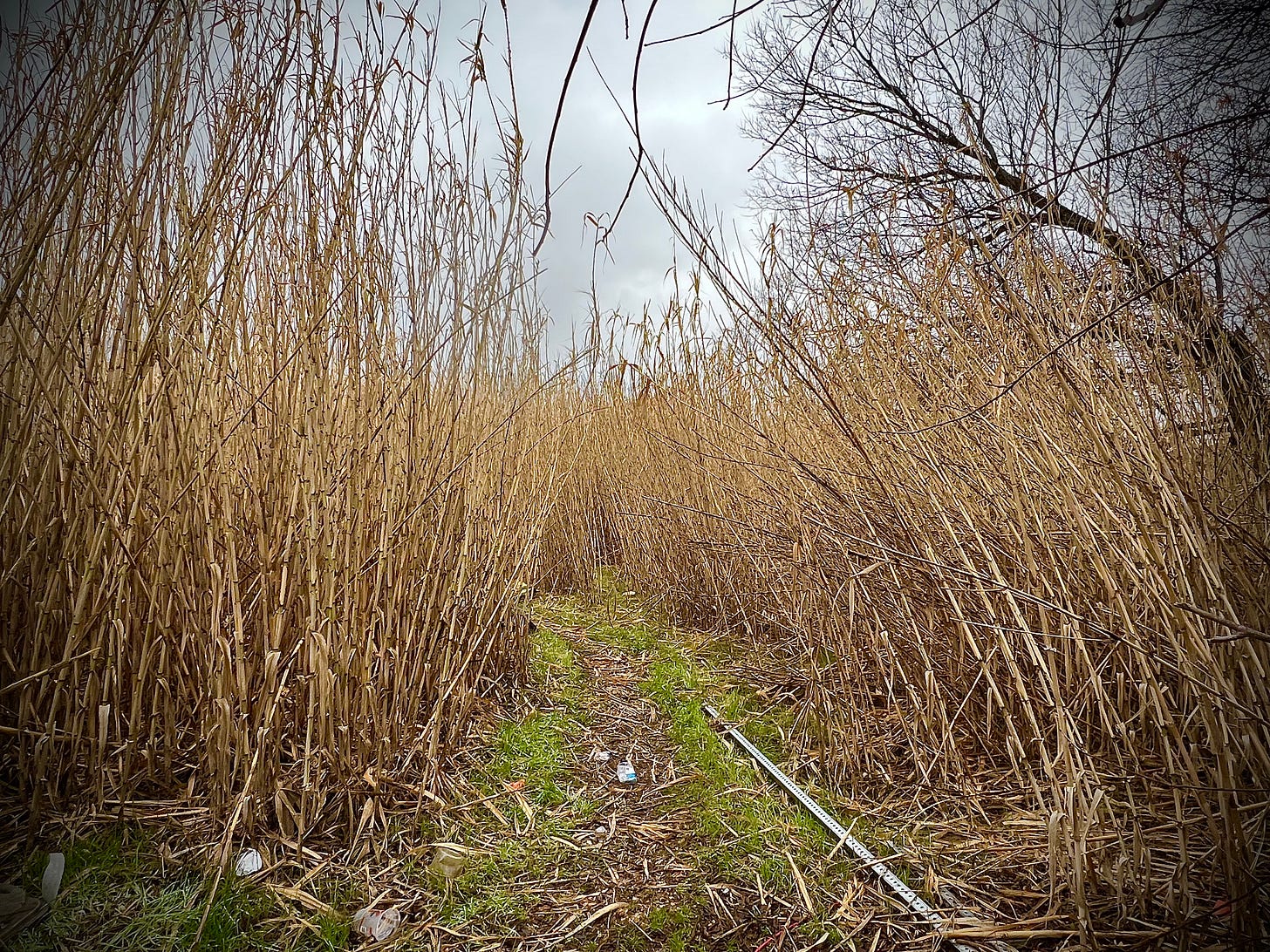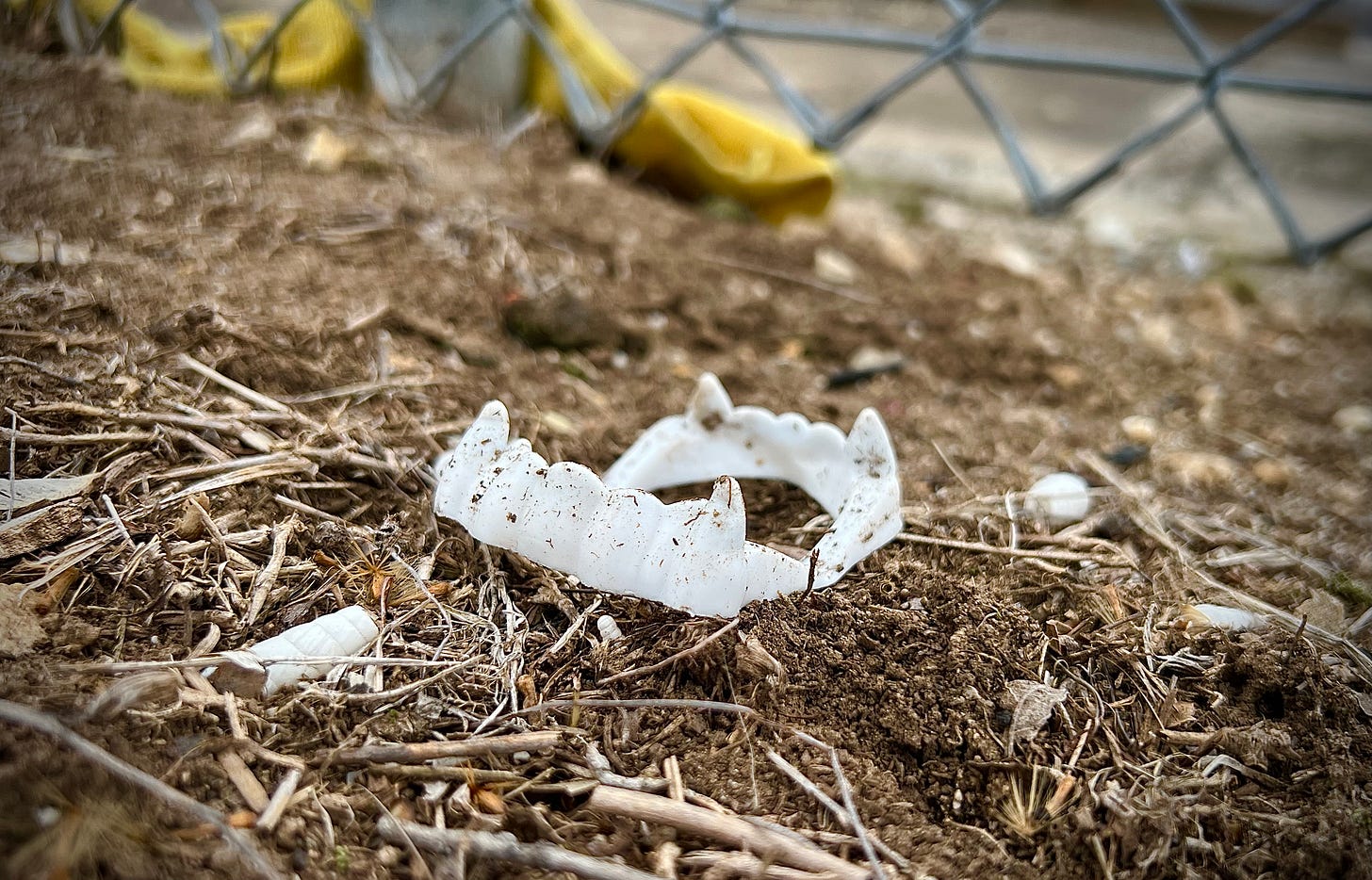Winter in the feral city
Sunday a friend visiting from New York and I went for a walk in the weird woods, and saw the first butterflies of the season. Red Admirals, the ones they say were Nabokov’s favorites, fluttering close to the ground, searching for nectar amid the sparse early foliage. It got me thinking spring must finally be arriving, after a series of crazy cold snaps. Then we got distracted by antlers, a less common sight in Manhattan. As the deer gang watched us warily through the trees, a pair of caracara glided over low, just above the treetops.
When we got back to the house we gathered up the family members who had hung back, and walked down to see the heron rookery behind the abandoned warehouses. The caracara appeared again, this time above the street. And then again, after we said our goodbyes and my wife and daughter and I returned to the house. They were on some kind of high speed patrol, riding on a western wind that was stronger and colder than I had noticed when we were down in the trees.
That morning the East Austin Street Retriever and I had headed out right at daybreak, walking into the empty lots behind the dairy plant, an area we had not explored much for many months. We saw scat that suggested feral hogs have moved into the area, something we hadn’t encountered on this side of the river before. The invasive grasses that dominate that field were all at peak dormancy, the Johnson grass mostly broken down to the ground while the tall cane got its edgeland Wyeth on, and an autumnal palette dialed up with the rising sun. At the far end, where the loop road curves around to run under the bridge, and the cane grows so thick that the desire paths of the drifters turn it into a labyrinth, we could see the huge blue tarps of a new camp that has settled in over the winter. And when we turned around to look back where we had come from, for the first time you could see the new towers of technocapital rising up over the treeline.
All over the field, you could also see the native wildflowers coming up through the cover, persistent and resilient, proof that the erasure of what was here before is never as complete as it seems. The cardinals and tits were busy building their nests, and so were the hawks that roost in the tall cottonwoods. I noticed one insulated with the same kind of industrial materials as the cardinals more consistently salvage from this urban habitat.
On Tuesday the temperature dropped from the mid-80s to the high 20s, and stayed cold the rest of the week, making one wonder how the early birds who normally find things consistently warmer by the end of February would fare. I spotted the first caterpillar of the year crawling across the concrete outside our front door. It was still there the next day, frozen in place.
On the day we used to call Washington’s birthday I went for a long run while it was nice and hot, across the river to the new trails the nonprofit on whose board I sit had made through a back part of a newer municipal park. The path runs through a bottom land arboretum where a beautiful creek flows along the edge of a bluff above the river. There is plenty of dumped concrete in there, lots of big chunks of old drainage pipes, but the ecology of the woods has been restored and so much other trash cleaned out through community pick-ups over the past decade that you don’t mind the rubble that’s left. The overall picture could leave you believing nature is winning, even if you know it got a lot of help from humans, including my friend who runs that restoration project, the only elf I have ever met who has been shot by rubber bullets.
When the arboretum trail crosses the creek, it traverses the bluff up to a little spot behind the community college campus and the municipal golf course where you can have close encounters with the nature that was here long before us, in the form of three majestic oaks that each must be hundreds of years old. The most ent-like trees you could ever see in Texas, there in a spot that until recently was hidden in plain sight, off the curb of a side road at the edge of town, marked only by a metal cable draped between two short poles.
One of those trees, the biggest one, has one branch that looks like it might have been tied down as a signal when it was young, maybe to mark the nearby spring my friend has helped recover. People have found lots of antiquities under that tree, and there are settler stories of camps on these bluffs along the river east of the original town they first called Waterloo. Monday when I jogged past it, I noticed for the first time how you can now see even more of the new high-rises of the fastest-growing city in America perfectly framed by the two main trunks of that ancient oak, which an arborist estimated could be five-hundred years old.
I shared one of these pics on Twitter, the one from the empty field behind the dairy plant, and one person, evidently a fantasy writer, remarked that “the more we move into cities, the more space is left for wilderness.” That’s a sentiment I understand but have never found especially persuasive. That notion that nature is what you find outside the city is especially strong in the U.S., where life’s middle class victory condition for many seems to be having a second home in the country, at the edge of the frontier of their imaginations. And while it’s true that you can find places that are less completely overwritten by urban development or by agriculture, there’s a wild city hiding in plain sight, one that to me is a truer wilderness in some respects than my favorite national parks.
The English writer China Miéville, who has a particular gift for imagining fantastical cities, wrote a novel called The City & the City that I learned about only when my editor used it as a comp for my first book. It tells the story of a detective investigating a murder in two cities that share the same physical space but are divided by a border constructed entirely from human conception. Maybe it was because I was reading Miéville’s history of the Russian revolution this week that I got to thinking about that concept, as I considered the ways one can walk the human city and simultaneously follow the interstitial paths of wild nature it harbors.
The woods where the coyotes and owls live behind the factories are decorated every season with the tags of surveyors, orange and blue ribbons they tie to branches and bushes as they make the land fit the maps maintained on the registries of the state. The tags stand out in winter, against the grays and browns of the bare timber. The boundary lines they demarcate are not otherwise visible, especially not to the animals. But they are the physical means whereby the land is divided up into units legible to the law, endowing it with the alienability. Just ask George Washington, who first made his name as a surveyor.
Wild animals are among the only things in the city not counted on the official ledgers that enable the transmutation of nature into Capital. That invisibility is an essential part of what keeps them wild, even as it is also one of the key ingredients that lets them be treated as expendable, without recognizable value. There’s increasing talk these days about evolving the law to more clearly recognize the rights of other species, and even of flora and ecosystems, and reading those discussions makes me wonder how long it is until we decide that we must number or name each one of them in order to save them, and if that will really be a good thing.
The animals that live among us all have their own systems of territorial dominion, and even of personal property. Our dogs can read many of those markers, with their nose. It’s harder to tell how much wild animals perceive the boundaries we draw, other than the ones we make into tangible barriers designed to keep them out. At night when the foxes sneak under the fence behind the door factory to go prowl behind the diners and dumpsters, one is reminded how permeable those barriers are, and how simultaneously fictional and absolute are the lines they draw. A reminder that all borders are fictions we choose to enforce for our own selfish benefits, in a week when people are dying over one.
Further reading
For more on George Washington, our founding surveyor and real estate developer whose birthday gave me time for an extra long run Monday, the Library of Congress has a huge trove of digitized maps and documents.
For more on the emerging science, philosophy and law of the rights of animals, the new issue of The New York Review of Books has an excellent roundup by Martha Nussbaum.
On the subject of caracaras, thanks to author and friend of Field Notes Derryl Murphy for telling me about Jonathan Meiburg’s A Most Remarkable Creature, an amazing-sounding book about caracaras published last week by Vintage. The book focuses on the South American species of caracara, which Meiburg along with Darwin deems the world’s smartest birds of prey, and I am excited to read it when my copy comes in.
My exchange with those two got me to pull my favorite caracara trailcam video from the vault, footage of a caracara fighting with a group of black vultures over an armadillo carcass, about which Meiburg noted something I had missed: “how the caracara drains the blood from its facial skin (making it entirely yellow instead of orange) as a dominance signal.”
This week’s news got me reading about the natural history of Ukraine, which led me to learn about how the country contains some of the best-preserved ancient and primeval European forests, large chunks of which have very recently been more formally protected. Here’s a deep study of one — an “Inventory of the Largest Primeval Beech Forest in Europe” from a team of Ukrainian and Swiss researchers. If that’s too dense, try this video meme from the YouTube channel of Ukraine’s chapter of the World Wildlife Federation.
Field Notes will be off the next couple of weeks, in the field and getting our place ready for spring. Stay safe, and hope (or work or pray) for peace after a week that feels like it’s getting its 1914 on.











